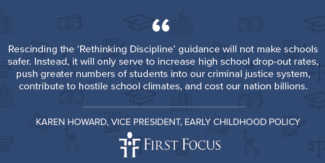On Tuesday, the Federal School Safety Commission formed in the wake of the tragic school shootings in Parkland, Florida, issued its report with recommendations on policies to improve school safety. Unfortunately, the report recommends the rescission of “Rethinking Discipline,” the policy guidance that the Department of Education and Department of Justice issued in 2014 to address one of the main drivers of the school-to-prison pipeline: glaring disparities in school discipline of black and disabled children and youth that pushes them out of school and into the criminal justice system. Rescinding the Rethinking Discipline guidance will not make schools safer. Instead, it will only serve to increase high school drop-out rates, push greater numbers of students into our criminal justice system, contribute to hostile school climates, and cost our nation billions in criminal justice and other expenditures.
The school-to-prison pipeline is the product of draconian school disciplinary policies that require suspensions, expulsions, school-based arrests, and referrals to law enforcement for relatively minor, non-violent infractions, such as tardiness and insubordination. Although students of color do not misbehave more than white students, a recent GAO report shows that these zero-tolerance policies are disproportionately enforced against students of color and disabled students. From suspensions and expulsions to in-school arrests and referrals to the juvenile justice system, black students are overwhelmingly subject to disparate disciplinary actions.
For instance, in 2014, black students comprised 15.5 percent of all public-school students, yet represented 39 percent of students suspended from school in 2014. To put this disparity in context, though white students outnumbered black students by 17 million in K-12 public schools in 2014, nearly 176,000 more black students were suspended from school than their white peers. Meanwhile, black girls are suspended more than 5 times as often as white girls and at higher rates than any other racial group. Unfortunately, these disparities begin as early as preschool. Black children are just 18 percent of public preschoolers, yet nearly one-half of preschool children with more than one suspension are African American.
Similarly, students with disabilities, who comprise 12 percent of all public school students, accounted for nearly 25 percent of students who were suspended, referred to law enforcement or arrested for a school-related offense. The discrepancy is even worse for black students with disabilities, with more than 1 in 4 black boys with disabilities, and one in five black girls with disabilities suspended every year.
Inequalities in school discipline create lasting harm. Students who are expelled or suspended from school are nearly 3 times more likely to drop out of school and have contact with the juvenile justice system the following year. There is a direct correlation between high school drop-outs and our high rates of incarceration. Nationally, 68 percent of all males in prison do not have a high school diploma.
In addition to the devastating impacts on students of color and disabled students, exclusionary disciplinary measures bear a steep national price tag. Students who drop out of school earn less money, and thus pay less in taxes. They are less likely to have health insurance, leading to worse health outcomes and greater health care expenditures. They are more likely be arrested and incarcerated, which costs taxpayers in prison costs. And they are more likely to rely on public assistance. According to the UCLA Civil Rights Project, the suspension of 67,000 10th grade students over one year cost our nation in excess of $35 billion annually.
The Federal School Safety Commission’s misguided recommendation to rescind the guidance ignores what the facts clearly tell us. The school-to-prison pipeline reduces educational opportunities and perpetuates racial disparities, fuels youth entering our juvenile justice system, and contributes to hostile school environments. The recommendation also stands in stark contrast to Congress’s bipartisan passage of the Juvenile Justice Reform Act of 2018, which requires states to track data on racial disparities in the juvenile justice system and develop concrete plans to address those disparities, which include addressing the root causes of youth entering the criminal justice system.
We urge the Federal School Safety Commission and Secretary DeVos to reject the Commission’s recommendations and instead work with school districts to expand upon the 201guidance to eliminate the school to prison pipeline.
